In the spring of 2016, the DAO, a decentralized venture capital fund built on top of Ethereum, was hacked to the tune of $50 million USD, a third of the money that the DAO had raised.
This sparked a contentious debate within the fledgling Ethereum community around the underlying philosophy of the blockchain. The Ethereum developers proposed a hard fork that would essentially reverse the hack and return users’ ETH. A number of Ethereum community members lashed out at this proposal. They believed that the proposed hard fork violated the immutability of Ethereum: the principle that previous transactions on a blockchain ought to be treated as permanent and irreversible.
This contingent refused to adopt the new hard fork and instead continued to use the unforked version of Ethereum — renamed Ethereum Classic. Much to the surprise of spectators, the Ethereum Classic hard fork didn’t substantially damage the overall market cap of Ethereum, and the combined market caps of Ethereum and the Ethereum Classic fork were actually higher than the market cap of Ethereum prior to the fork.
So, how far has Ethereum Classic come since the hard fork? Both Ethereum and Ethereum Classic aim to become decentralized, global computers that can power decentralized applications, or DApps—in that regard, therefore, the two blockchains can be seen as mutual competitors. So, we can ask the question: Has Ethereum Classic’s focus on immutability really made a difference in competing with Ethereum?
Let’s see how Ethereum Classic stacked up against Ethereum when the two chains first forked on July 30th, 2016:
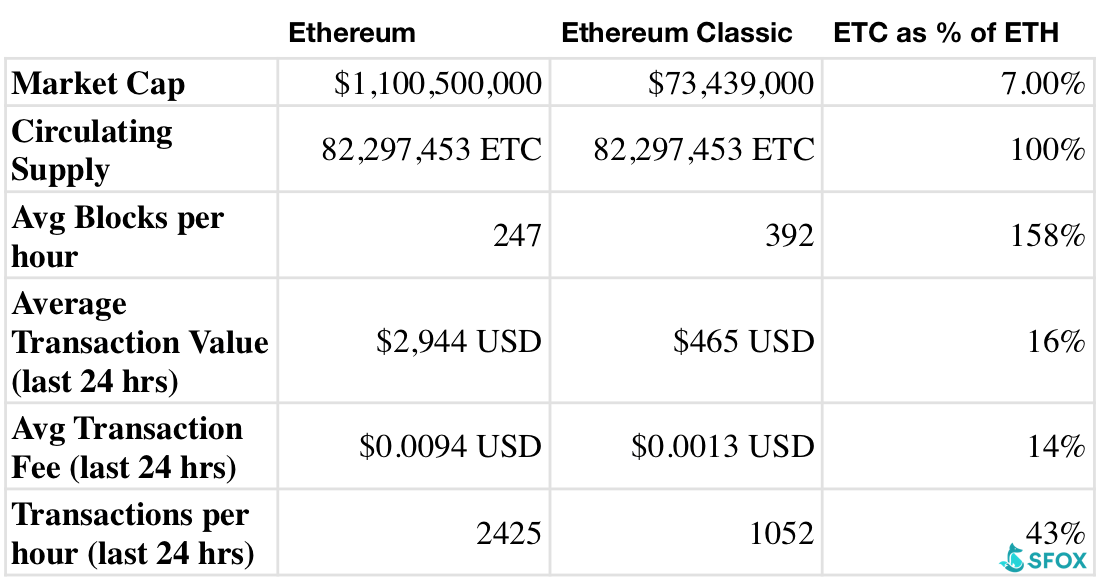
Here’s how the two compared as of last month, on February 25th, 2019:
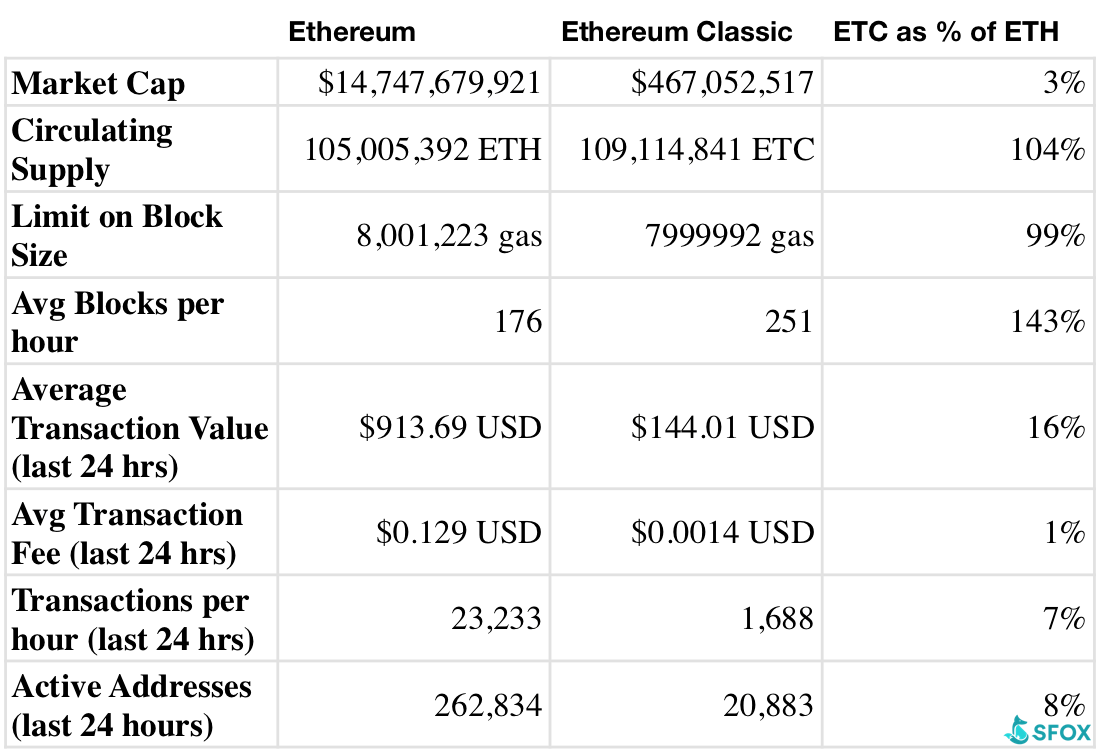
To understand how Ethereum compares with Ethereum Classic nearly three years after the fork, we’ll analyze both currencies along three critical axes:
- DApp Usage: How do DApp development and usage compare across Ethereum and Ethereum Classic?
- Transaction Volume: What do transaction volumes reveal about levels of adoption between Ethereum and Ethereum Classic?
- Mining: How does mining activity compare from Ethereum to Ethereum Classic?
Examining these different factors makes it clear that while Ethereum Classic’s promise to maintain immutability has allowed it to survive over the years, it hasn’t been enough to put a dent in the higher usage and adoption seen by Ethereum.
DApp usage on Ethereum is low — but DApp usage on Ethereum Classic is nearly nonexistent
Ethereum and Ethereum Classic both aim to be decentralized computing platforms that can power a range of decentralized applications. Despite this, there are currently very few DApps on Ethereum Classic and usage is nearly nonexistent. While Ethereum usage has declined since its 2017 peak, the platform boasts nearly 70x the number of DApps and 35x the daily active users of Ethereum Classic.
DappRadar, a registry for DApps, lists 1,403 different DApps on the Ethereum network. In contrast, Dapp Direct, a registry for ETC DApps, lists only 19 different DApps for Ethereum Classic.
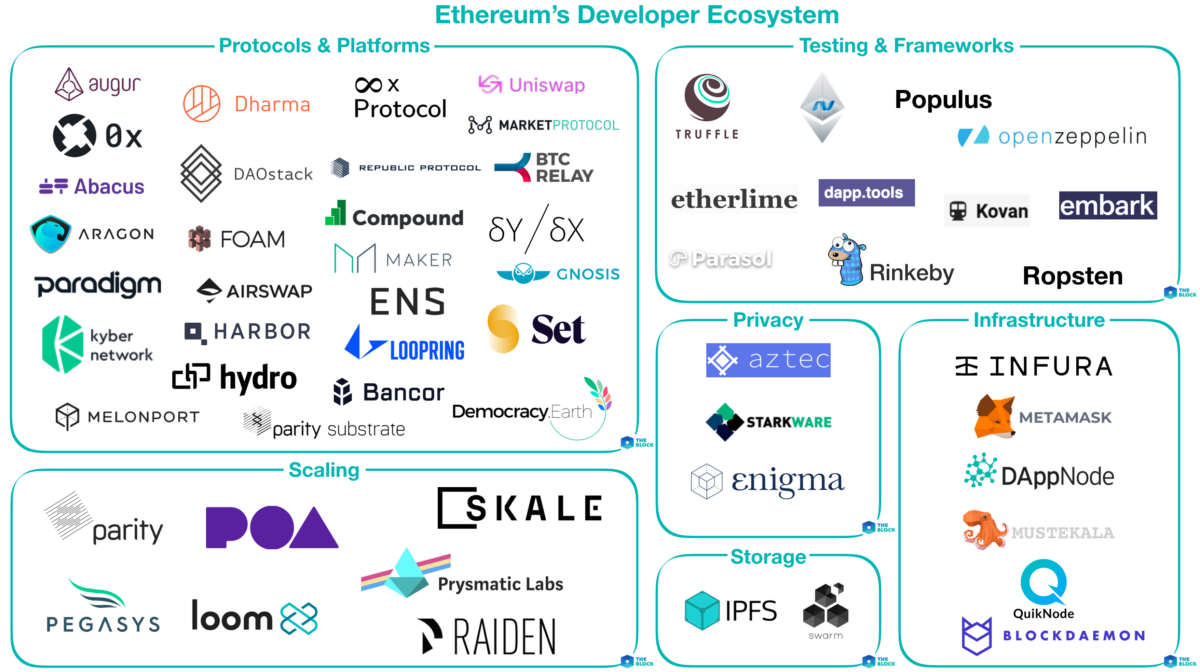
Part of this has to do with the fact that Ethereum has a much stronger advantage in terms of ecosystem. Developer tools like Truffle and Zeppelin help developers write Ethereum DApps, while infrastructure providers like Infura help power them, and wallets like MetaMask allow end users to transact with them. Ethereum Classic developers, on the other hand, can use certain tools developed for Ethereum for Ethereum Classic, but it sorely lacks natively developed tools, making it harder to build and maintain ETC DApps.
While Ethereum Classic has technically existed as long as Ethereum, the ETC Dev team member Donald McIntyre noted that roughly 90% of DApps and core developers moved to the new Ethereum chain, leaving Ethereum Classic to build an ecosystem from scratch. It’s possible that Ethereum Classic is simply less mature than Ethereum, leading to fewer DApps at this point in time.
Another reason for this disparity may have to do with the fact that there is simply a lot more money in the Ethereum ecosystem. When Ethereum launched, 12 million ETH was allocated for developers, and another 60 million was premined for investors to buy. This represents over 70% of the current supply of ETH. As ETH increased in value, developers and investors reinvested some of their earnings into helping develop the protocol. A prime example of this is ConsenSys, a venture capital production studio founded by Joseph Lubin, one of the Ethereum co-founders. ConsenSys has helped develop 50+ projects for Ethereum. Meanwhile, Ethereum Classic developers and investors who weren’t previously involved in Ethereum didn’t benefit from the split.
As of February 23, 2019, there were around 8,627 daily active users across Ethereum DApps, measured by the number of unique addresses that had sent a transaction to a DApp. That’s not a whole lot, but it’s significantly higher than the number of daily active users on Ethereum Classic.
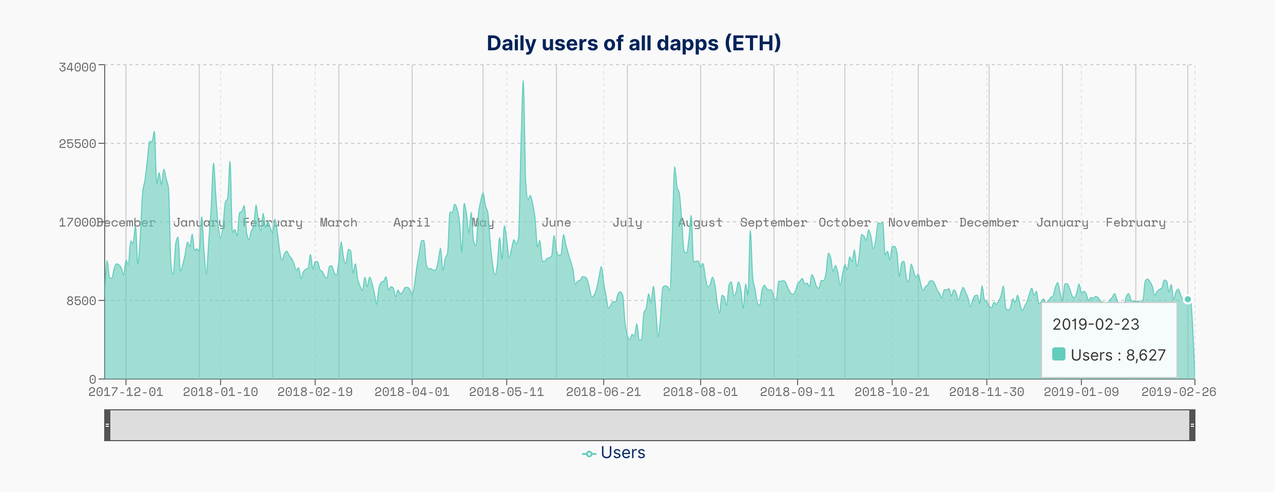
During the same time, there were 27 daily active users across Ethereum Classic DApps.
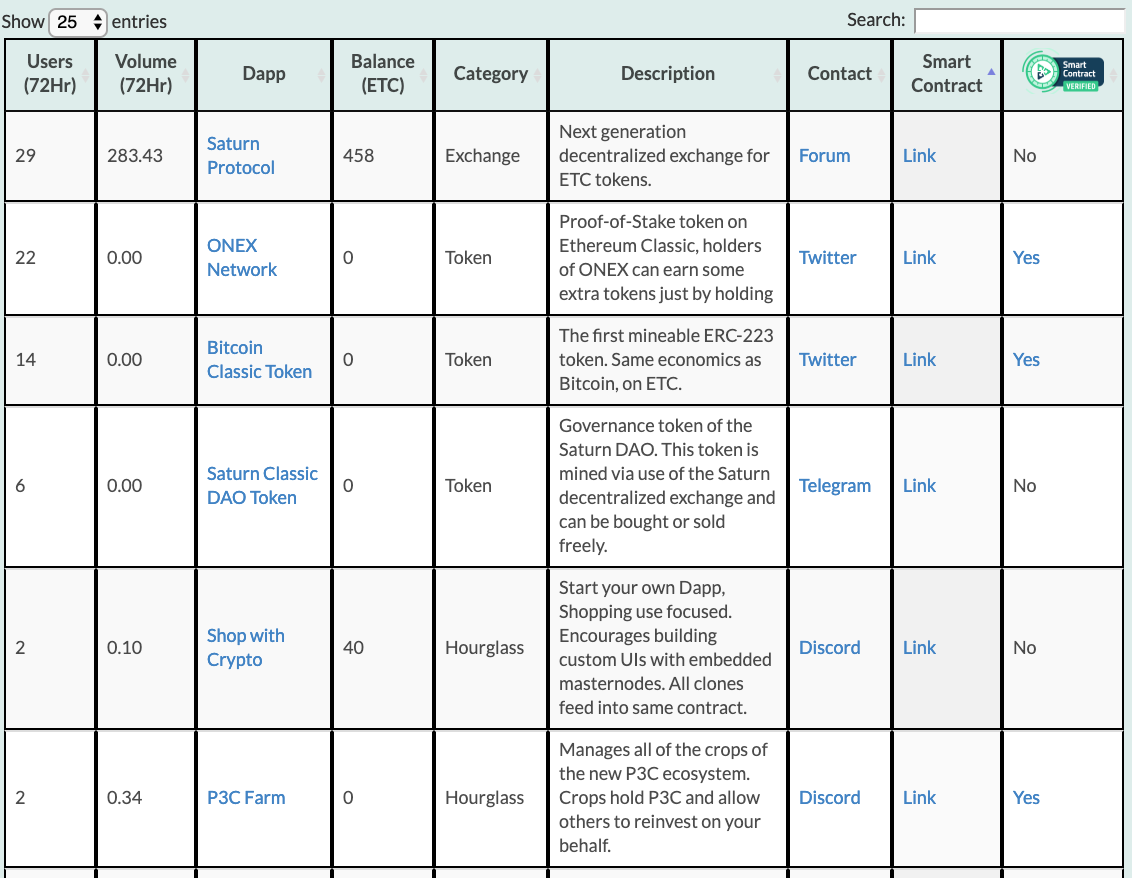
Data around usage and DApp development suggest that, at the end of the day, developers and users care more about real-world usability than ideological principles such as immutability. While it’s true that Ethereum had a more mature ecosystem prior to the hard fork, in the past three years, Ethereum Classic has failed to close that gap in terms of DApp development or usage.
Ethereum processes more transactions than Ethereum Classic, but transaction volume on both chains remains flat
Ethereum and Ethereum Classic both seek to become a global, decentralized computer that can power transactions across decentralized applications. Growth in transaction volume for both chains depends on their ability to get people to develop DApps and use them, participate in Initial Coin Offerings (ICOs), and more.
Because the vast majority of this activity takes place on Ethereum rather than Ethereum Classic, it’s unsurprising that Ethereum does over 14 times the transaction volume compared to Ethereum Classic.
Since the Ethereum Classic hard fork in July 2016, Ethereum’s transaction volume spiked at a high of 1.35 million transactions a day in January 2018, following the ICO boom on Ethereum in 2017 and the development of popular DApps such as CryptoKitties.

As the market for ICOs cooled and DApp usage began to drop, Ethereum’s transaction volume has fallen gradually over the past year, settling at a range between 380,000 and 500,000 transactions per day.
Over the same time period, Ethereum Classic’s transaction volume has remained largely flat beyond a couple of short-term spikes. As of late February 2019, Ethereum Classic does roughly 40,000 transactions a day, which is 18% higher than the 34,000 transactions per day it saw at the time of the hard fork.

If you look at Ethereum Classic’s current transaction volume, however, three years after the hard fork, it actually looks pretty similar to a graph of Bitcoin’s transaction volume, early in the history of the network. For the first two years following launch, Bitcoin’s transaction volume remained essentially stagnant, before growing explosively from 50,000 to 100,000 transactions a day. In this regard, it’s possible that Ethereum Classic is simply at an early stage of maturation than Ethereum, explaining its low transaction volume.

While transaction volumes on Ethereum and Ethereum Classic have both declined over the past year, the overall transaction volume on Ethereum dwarfs that of Ethereum Classic. This is likely thanks to the fact that the majority of DApp development and ICOs occur on Ethereum’s network rather than on Ethereum Classic’s. It’s possible that Ethereum Classic is simply a younger network than Ethereum, but if it wants to catch up, it will have to attract more developers and DApps to the platform.
While mining profitability is the same on Ethereum and Ethereum Classic, Ethereum commands a much higher hash rate
Both Ethereum and Ethereum Classic use the same Ethash mining algorithm, which means that both currencies can be mined on the same hardware. However, with a hash rate that’s currently at around 155 terahashes per second, Ethereum has over 17 times more computing power devoted to mining and securing the network than Ethereum Classic.
The table below compares key mining metrics between Ethereum and Ethereum Classic.
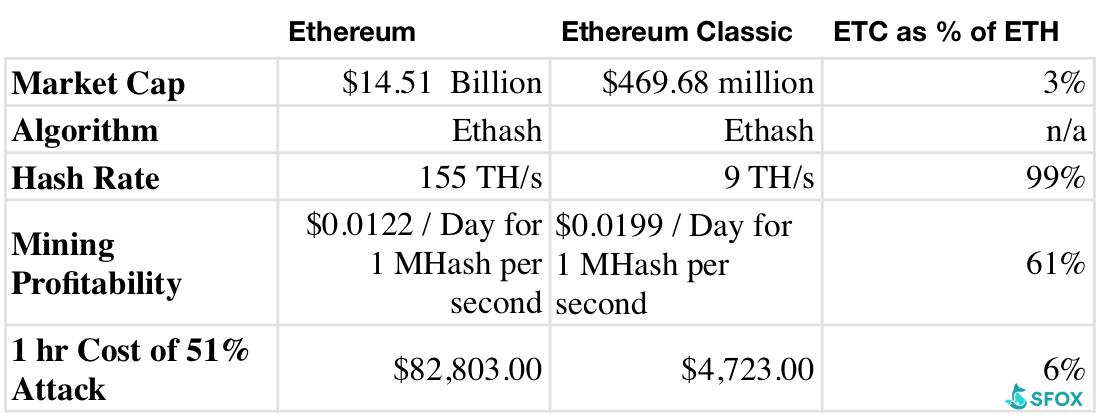
For both Ethereum and Ethereum Classic, over 40% of the recent blocks have been mined by two pools: Ethermine and Nanopool.

Pools choose what to mine based on what’s most profitable for them. As mining profitability between Ethereum and Ethereum Classic has remained even over time, many pools choose to mine on both Ethereum and Ethereum Classic.
Mining profitability evens out between the two chains because Ethereum and Ethereum Classic share the same Ethash consensus algorithm. If miners start contributing more hash power to Ethereum, the difficulty of mining Ethereum increases, leading some miners to switch to mining Ethereum Classic. Since miners are rational and profit-seeking, mining profitability ends up at an equilibrium.
The overall hash rate on Ethereum, however, is much higher than it is on Ethereum Classic, which is what you’d expect given its higher market capitalization.

A higher hash rate means that it’s much more expensive to launch a 51% attack on Ethereum than Ethereum Classic. According to Crypto51, the current cost of launching a 51% attack on Ethereum is $82,803 USD per hour, compared to only $4,723 for Ethereum Classic.
This difference in hash rates came back to haunt Ethereum Classic this past January as a block reorganization revealed that the chain had been successfully 51%-attacked. Because smaller chains like Ethereum Classic attract less hash power, they cost less to attack. Making matters worse is the fact that Ethereum Classic shares the same hashing algorithm as Ethereum. That means that an attacker can rent Ethereum mining hardware through a cloud mining service like NiceHash to launch an attack. As of late February, it would take less than 4% of the hash power on Ethereum to 51%-attack Ethereum Classic. The Ethereum Classic development team is considering changing the mining algorithm for ETC, but until they do, Ethereum Classic remains vulnerable to similar attacks in the future.
Pragmatism beats ideology
The original split between Ethereum and Ethereum Classic arose as a matter of ideology, with Ethereum Classic promising to maintain the immutability of the blockchain. In the years that have followed, it appears that developers and users have favored pragmatism over ideology. While Ethereum Classic offered an alternative to Ethereum on the basis of immutability, actual usage in terms of DApps, transaction volume, and mining activity haven’t kept up.
Perhaps, then, one possible solution is for Ethereum Classic to not be a competitor to Ethereum, but rather a collaborator with Ethereum: some, such as former ETC Cooperative Director Anthony Lusardi, believe that both chains stand to benefit by working with each other towards common goals, rather than trying to undermine each other. Given the current state of Ethereum vs. Ethereum Classic, that might very well be a favorable outcome in the long-run.
The above references an opinion and is for informational purposes only. It is not intended as and does not constitute investment advice, and is not an offer to buy or sell or a solicitation of an offer to buy or sell any cryptocurrency, security, product, service or investment. Seek a duly licensed professional for investment advice. The information provided here or in any communication containing a link to this site is not intended for distribution to, or use by, any person or entity in any jurisdiction or country where such distribution or use would be contrary to law or regulation or which would subject SFOX, Inc. or its affiliates to any registration requirement within such jurisdiction or country. Neither the information, nor any opinion contained in this site constitutes a solicitation or offer by SFOX, Inc. or its affiliates to buy or sell any cryptocurrencies, securities, futures, options or other financial instruments or provide any investment advice or service.



